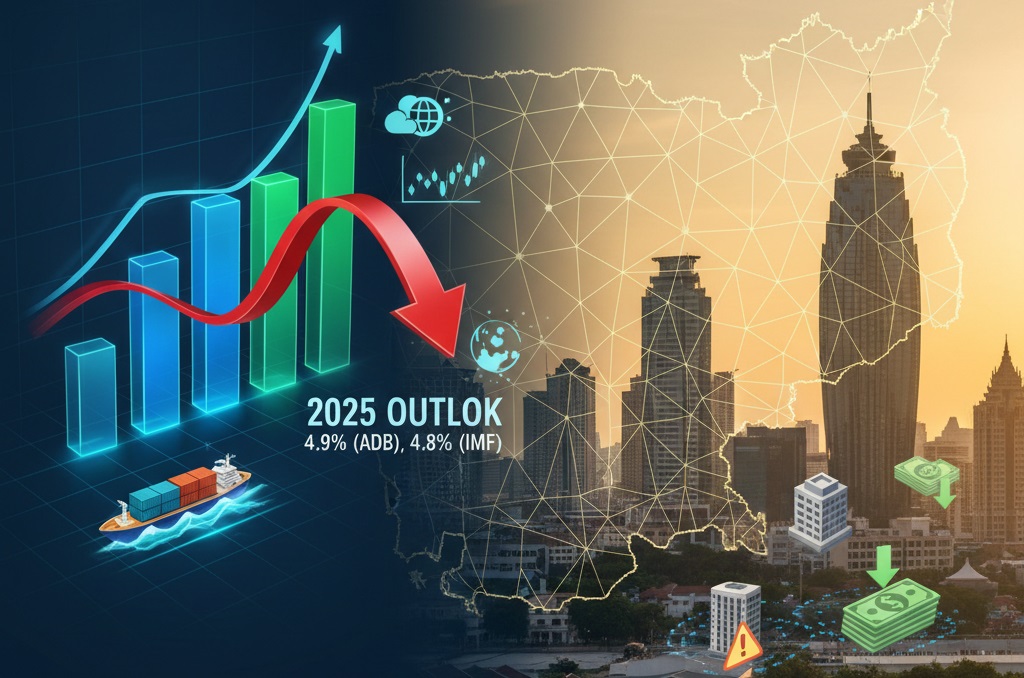I. Introduction: A Moderating Economic Trajectory
Cambodia’s remarkable economic resilience is once again being tested as the Kingdom navigates a complex global landscape marked by trade policy uncertainties and regional geopolitical risks. Following years of robust growth, the consensus among multilateral institutions points toward a moderation in the Gross Domestic Product (GDP) expansion for 2025, falling below the government’s initial, more optimistic targets.
The updated forecasts reflect a challenging external environment, necessitating a renewed focus on accelerating structural reforms to diversify the economy and build long-term resilience.
II. The Revised 2025 Economic Forecasts
Major international financial institutions have collectively revised downward their projections for Cambodia’s 2025 economic performance, reflecting a sobering assessment of both global and domestic vulnerabilities.
| Institution | Latest 2025 Growth Forecast | Key Rationale for Revision |
| Asian Development Bank (ADB) | 4.9% (Revised Down from 6.1%) | Geopolitical tensions with Thailand, uncertainty in the US export market, and border-related tourism dampening. (Source: ADB Asian Development Outlook, September 2025) |
| International Monetary Fund (IMF) | 4.8% | External headwinds from trade policy uncertainty, border dispute risks, and financial sector vulnerabilities (rising NPLs). (Source: IMF Staff Completes 2025 Article IV Mission, September 2025) |
| World Bank | 4.0% – 4.8% | Global trade uncertainties, prolonged property sector slowdown, and the urgent need for economic diversification beyond construction and garments. (Source: World Bank Cambodia Economic Update, June/October 2025) |
While these figures contrast sharply with the government’s previous ambition of achieving around 6.3% growth, they underscore the immediate pressure points affecting the economy.
III. Key Headwinds and Vulnerabilities
The consensus suggests that the slowdown is primarily driven by three critical factors:
1. Geopolitical and Trade Uncertainty
The recent military and trade tensions with Thailand, despite the implementation of the border ceasefire confirmed by the Cambodia-Thailand GBC Joint Statement, are already weighing on cross-border trade, tourism, and remittance flows, particularly in the border provinces. Furthermore, the global trade environment, including new US tariff policies, continues to create uncertainty for Cambodia’s vital export sector.
2. Financial Sector Vulnerabilities (Rising NPLs)
Domestic risks remain high, largely centered around the financial sector. The Non-Performing Loan (NPL) ratio has surpassed 7% in some banking segments (Source: IMF, September 2025), concentrated in the heavily exposed real estate and construction sectors. This prolonged property market slowdown could lead to corporate and household financial stress, dampening domestic credit growth and consumption.
3. Sectoral Reliance
Cambodia’s reliance on the four traditional growth pillars—Garments, Construction, Tourism, and Agriculture—leaves it exposed to external shocks. While garment and non-garment manufacturing remains robust, the need to transition to higher-value-added sectors is critical to sustain growth momentum toward the country’s goal of attaining upper middle-income status by 2030.
IV. The Call for Accelerating Structural Reforms
To counter these headwinds and put the economy on a more resilient trajectory, both the IMF and the World Bank have strongly urged the government to accelerate foundational structural reforms:
- Fiscal Prudence and Revenue: A gradual, growth-friendly fiscal consolidation is essential to rebuild financial buffers. This includes strengthening revenue mobilization, primarily by reducing extensive tax exemptions and enhancing tax compliance (Source: IMF, September 2025).
- Economic Diversification: Urgent action is needed to diversify the economy beyond construction and garments, focusing on high value-added manufacturing and services. Policies must be aligned with the Industrial Development Policy (IDP) to enhance competitiveness.
- Governance and Business Environment: Improving the business environment by strengthening governance, anti-corruption efforts, and the rule of law is critical to attracting quality Foreign Direct Investment (FDI) and preparing the nation for its impending Least Developed Country (LDC) graduation by the end of 2029.
- Digital Transformation: Strategic investments in digital public infrastructure, human capital development, and cybersecurity are crucial to raising economic productivity and unlocking new drivers for inclusive growth (Source: ADB, April 2025).
V. Conclusion: Resilience through Reform
While the revised growth outlook for 2025 presents challenges, the overall assessment remains one of resilience, underpinned by a rebounding tourism sector and steady industrial activity. However, the path to sustained, high-quality growth will depend less on external demand and more on the commitment to ambitious structural reforms. By addressing financial sector risks and decisively implementing reforms to enhance productivity and competitiveness, Cambodia can mitigate external shocks and secure its long-term development goals.

